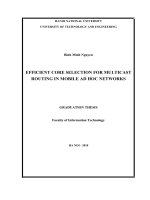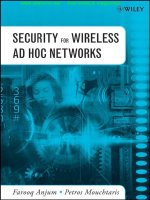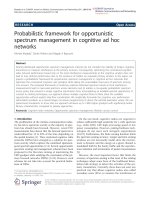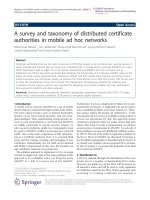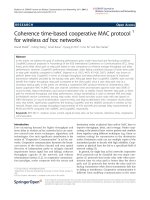Topology Control in Wireless Ad Hoc Networks phần 4 pot
Bạn đang xem bản rút gọn của tài liệu. Xem và tải ngay bản đầy đủ của tài liệu tại đây (177.08 KB, 10 trang )
5
th
ACM MobiHoc – Tokyo, May 24, 2004
Istituto di
Informatica
e Telem atica
RNG, GG, and other routing graphs (2)
Energy-efficient communication: 5/7
Other routing graphs considered in the literature are the Restricted
Delaunay Graph [Gao et al.01] and the Yao Graph [Li et al.03a]
The table below summarizes the power stretch factor and maximum
node degree of these routing graphs, assuming α = 2
Remark 1: the Gabriel Graph has optimal power stretch factor
Remark 2: all the routing graphs above are sparse (i.e., constant average
node degree), but have maximum node degree linear in n
YG
RDG
GG
RNG
n-1
≈4.05
Θ(n)≈25.84
n-11
n-1n-1
DegreePower
5
th
ACM MobiHoc – Tokyo, May 24, 2004
Istituto di
Informatica
e Telem atica
Energy-efficient broadcast
Energy-efficient communication: 6/7
Other problem considered in the literature: determination of energy-
efficient broadcast graphs
Similarly to the case of unicast, the concept of broadcast stretch factor of
a subgraph G’ of G can be defined
Also in this case, the goal is to find sparse broadcast spanners that can
be computed in a distributed and localized fashion
Unfortunately, this task is more difficult than in the case of unicast
5
th
ACM MobiHoc – Tokyo, May 24, 2004
Istituto di
Informatica
e Telem atica
Energy-efficient broadcast (2)
Energy-efficient communication: 7/7
[Cagali et al.02] and [Liang02]: the task of finding the energy-optimal broadcast
tree rooted at an arbitrary node u of G is NP-hard
[Wieselthier et al.00]: the authors introduce three greedy heuristics for the
minimum-power broadcast problem, based on the construction of the MST
[Wan et al.02]: it is proved that the broadcast stretch factor of the MST is c, for
some 6 ≤ c ≤ 12
Unfortunately, the MST cannot be computed using only local information
Open problem: no distributed and localized algorithm that constructs a broadcast
spanner is known
5
th
ACM MobiHoc – Tokyo, May 24, 2004
Istituto di
Informatica
e Telem atica
Topology control protocols
TC protocols: 1/12
Previous Section: emphasis on finding a subgraph G’ of the communication graph
with “good” properties (for unicast/broadcast communications).
Implicit in the previous approach: nodes adjust their transmit power on a per-
packet basis (e.g., transmitting a message along an energy-efficient path in G’)
Other research focused on trying to adjust the maximum nodes’ transmitting
range, in such a way that the communication graph remains connected.
the topology of the communication graph itself is changed: energy consumption is
reduced, and network capacity is increased
Implicit in this approach: nodes set the maximum transmitting range periodically,
and use the same (maximum) transmit power to send the messages.
We call this approach periodical topology control
5
th
ACM MobiHoc – Tokyo, May 24, 2004
Istituto di
Informatica
e Telem atica
TC protocols: desired properties
TC protocols: 2/12
Ideally, a TC protocol should:
– Generate a connected communication graph of low energy cost
– Generate a communication graph with small physical degree
– Be fully distributed, asynchronous, and localized (esp. in case of
mobility)
– Rely on “low quality” information
– Generate a connected topology free of unidirectional links
5
th
ACM MobiHoc – Tokyo, May 24, 2004
Istituto di
Informatica
e Telem atica
TC protocols: information quality
TC protocols: 3/12
Direct relationship between information quality and energy consumption:
the more accurate is the information used by the protocol (e.g., location
information), the more energy savings can be achieved
However, information quality (and, thus, the energy savings) must be
carefully traded off with the cost incurred for making the information
available to the nodes. With cost, we mean here either additional HW
required on the nodes (e.g., GPS receiver), or message overhead, or
both
5
th
ACM MobiHoc – Tokyo, May 24, 2004
Istituto di
Informatica
e Telem atica
Physical vs. logical node degree
TC protocols: 4/12
Major advantage of topology control: reduce interferences, thus
increasing network capacity
node degree = “measure” of expected interference (low is good)
So far, emphasis on reducing the logical node degree (number of edges
in the final communication graph), and not on reducing the physical node
degree (number of nodes in the transmitting range)
It is the physical node degree, not the logical, which determines the
expected interference
5
th
ACM MobiHoc – Tokyo, May 24, 2004
Istituto di
Informatica
e Telem atica
Physical vs. logical node degree (2)
TC protocols: 5/12
Example of communication graph produced by the CBTC protocol
Logical degree =
5
Physical degree = 10
5
th
ACM MobiHoc – Tokyo, May 24, 2004
Istituto di
Informatica
e Telem atica
Existing TC protocols
TC protocols: 6/12
RodopluMeng99:
– Goal: build a topology that minimizes the energy required to communicate
with a given master node (reverse of the broadcast problem)
– Drawbacks: non localized; GPS required
RamanathanRosales-Hain00:
– Goal: minimize the maximum of nodes transmitting ranges while maintaining
connectivity
– Drawback: centralized approach
BorbashJennings02:
– Goal: build the RNG in a distributed and localized fashion
– Drawback: directional information required
LMST [Li et al.03b]:
– Goal: build an approximation of the MST in a localized way
– Drawback: location information required
5
th
ACM MobiHoc – Tokyo, May 24, 2004
Istituto di
Informatica
e Telem atica
The CBTC protocol
TC protocols: 7/12
The Cone Based Topology Control protocol has been introduced
in [Wattenhofer et al.01][Li et al.01a]
– Basic idea (similar to the Yao Graph): a node u transmits with the
minimum power p
u,
ρ
such that there is at least one neighbor in every
cone of angle
ρ
centered at u.
ρ
= π/3
p
u,
ρ
u
